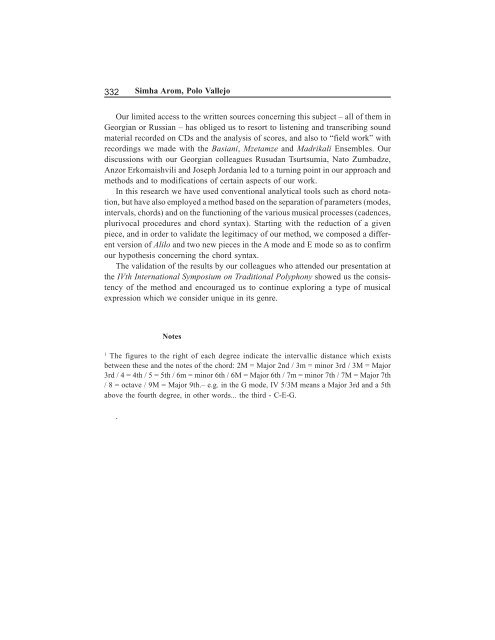Simha Arom & Polo Vallejo - International Research Center For ...
Simha Arom & Polo Vallejo - International Research Center For ...
Simha Arom & Polo Vallejo - International Research Center For ...
You also want an ePaper? Increase the reach of your titles
YUMPU automatically turns print PDFs into web optimized ePapers that Google loves.
332<strong>Simha</strong> <strong>Arom</strong>, <strong>Polo</strong> <strong>Vallejo</strong>Our limited access to the written sources concerning this subject – all of them inGeorgian or Russian – has obliged us to resort to listening and transcribing soundmaterial recorded on CDs and the analysis of scores, and also to “field work” withrecordings we made with the Basiani, Mzetamze and Madrikali Ensembles. Ourdiscussions with our Georgian colleagues Rusudan Tsurtsumia, Nato Zumbadze,Anzor Erkomaishvili and Joseph Jordania led to a turning point in our approach andmethods and to modifications of certain aspects of our work.In this research we have used conventional analytical tools such as chord notation,but have also employed a method based on the separation of parameters (modes,intervals, chords) and on the functioning of the various musical processes (cadences,plurivocal procedures and chord syntax). Starting with the reduction of a givenpiece, and in order to validate the legitimacy of our method, we composed a differentversion of Alilo and two new pieces in the A mode and E mode so as to confirmour hypothesis concerning the chord syntax.The validation of the results by our colleagues who attended our presentation atthe IVth <strong>International</strong> Symposium on Traditional Polyphony showed us the consistencyof the method and encouraged us to continue exploring a type of musicalexpression which we consider unique in its genre.Notes1The figures to the right of each degree indicate the intervallic distance which existsbetween these and the notes of the chord: 2M = Major 2nd / 3m = minor 3rd / 3M = Major3rd / 4 = 4th / 5 = 5th / 6m = minor 6th / 6M = Major 6th / 7m = minor 7th / 7M = Major 7th/ 8 = octave / 9M = Major 9th.– e.g. in the G mode, IV 5/3M means a Major 3rd and a 5thabove the fourth degree, in other words... the third - C-E-G..
















